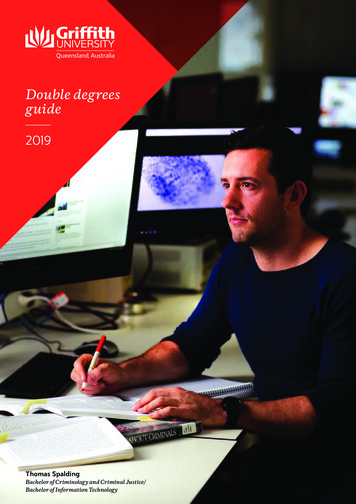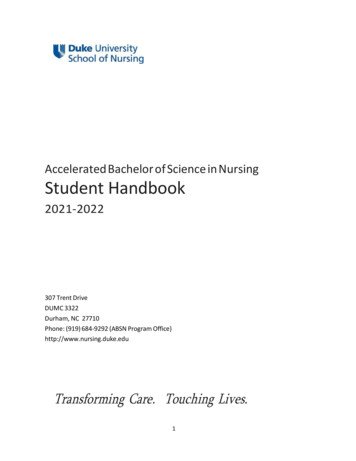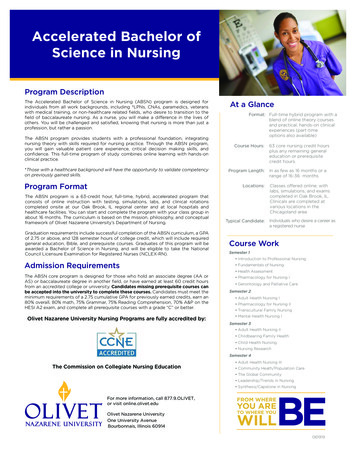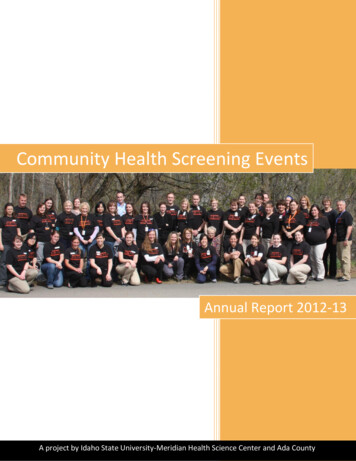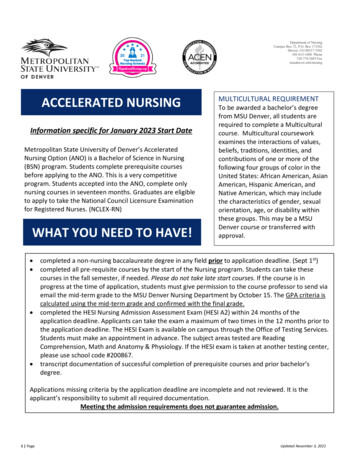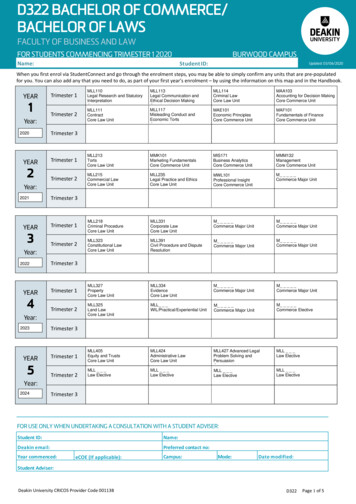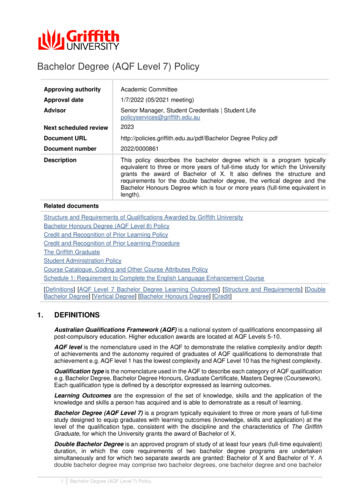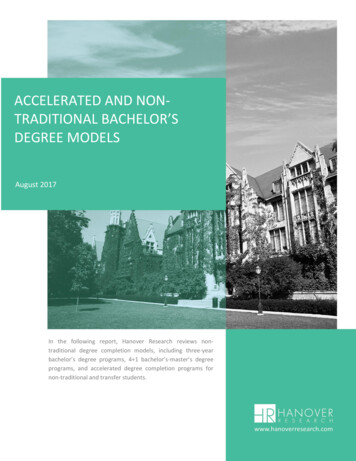
Transcription
ACCELERATED AND NONTRADITIONAL BACHELOR’SDEGREE MODELSAugust 2017In the following report, Hanover Research reviews nontraditional degree completion models, including three-yearbachelor’s degree programs, 4 1 bachelor’s-master’s degreeprograms, and accelerated degree completion programs fornon-traditional and transfer students.
Hanover Research August 2017TABLE OF CONTENTSExecutive Summary and Key Findings . 3INTRODUCTION .3KEY FINDINGS .3Section I: Trends in Alternative Degree Structures . 6OVERVIEW OF ALTERNATIVE DEGREE STRUCTURES .6MOTIVATIONS FOR ALTERNATIVE AND NON-TRADITIONAL PROGRAMS .8Cost Savings .8Time-to-Completion and Graduate Credentials .10MAJOR CHALLENGES OF ALTERNATIVE DEGREE STRUCTURES .10Scheduling, Alignment, and Curriculum Restructuring .10Operational Concerns .12Accreditation and Financial Aid .12Student Recruitment and Persistence .16Transfer Policies and Credit Options .17TRENDS IN CONSUMER EVALUATIONS OF INSTITUTIONAL EFFECTIVENESS .19Section II: Benchmarking Innovative Programs . 223-YEAR BACHELOR’S DEGREE PROGRAMS .22OTHER ALTERNATIVE DEGREE MODELS.284 1 Programs .28Degree Completion Programs .30 2017 Hanover Research2
Hanover Research August 2017EXECUTIVE SUMMARY AND KEY FINDINGSINTRODUCTIONThe following report reviews non-traditional degree completion models, including three-yearbachelor’s degree programs, 4 1 bachelor’s-master’s degree programs, and accelerateddegree completion programs for non-traditional and transfer students. The report comprisestwo sections:Section I: Trends in Alternative Degree Structures reviews recent literaturesurrounding non-traditional degrees of interest, including an overview of structuraloptions, student motivations, major challenges for institutions, and trends inconsumer evaluations.Section II: Innovative Programs reviews select accelerated and non-traditionalbachelor’s degree programs across the United States.KEY FINDINGSA review of nationwide identifies several alternative degree program options, ashighlighted in Figure ES.1 on page 5 below. Institutions that offer acceleratedprograms that reduce time to degree completion emphasize cost-savings and studentability to enter the workforce with a credential earlier than otherwise possible.However, each type of alternative degree program comes with its own benefits andchallenges, largely based on program goals and target students.o Three-year bachelor’s degree programs are increasingly offered at both publicand private institutions; students and institutions may see the fast-track as a wayto reduce costs, but the recent experience of such programs suggest that a limitednumber of students have actually enrolled in such programs and completed thedegree on time. Institutions typically advertise cost savings associated withcompleting a degree on an accelerated timeline; however, a review of theliterature and institutional models suggests that the real value of an acceleratedbachelor’s degree may be in early entry into the workforce and/or graduateschool.o 4 1 accelerated master’s degree programs have also increased across manyinstitutions in the United States over the last decade. These programs allowstudents to complete a bachelor’s degree and master’s degree a year ahead ofschedule—in a five-year timeline—by allowing undergraduate students tocomplete a limited amount of graduate coursework that counts toward both thebachelor’s and master’s degree. Among benchmarked programs, the number ofcredits that are counted toward both degrees ranges from a high of 16 credits(Northeastern University) to a low of 9 credits (High Point University).o Degree completion programs are aimed at non-traditional students with anassociate’s degree or prior college credits. Thus, these programs must include 2017 Hanover Research3
Hanover Research August 2017ample support for adult learners, including personalized academic advising andflexible course schedules designed for working professionals.Across multiple alternative degree program models, institutions must provideappropriate academic advising supports to ensure students understandexpectations and remain on track for accelerated graduation. Students participatingin combined bachelor’s-master’s degree programs must have access to clearinformation that allows them to complete needed pre-requisites to participate ingraduate coursework during their junior and/or senior year. Accelerated bachelor’sdegree students often must declare a major and carefully sequence their courses toremain on a three-year track, also requiring close academic advising. Furthermore,degree programs that depend on prior credit—including both degree completionprograms and three-year programs that target students who have earned prior creditin high school—institutions must clearly communicate policies surrounding credittransfer. Degree completion programs at Northeastern and Drexel highlightpersonalized academic advising that helps ensure maximal credit transfer and clearcommunication of requirements and designing a plan of study for incoming students. 2017 Hanover Research4
Hanover Research August 2017Figure ES.1: Summary of Alternative Degree Programs of InterestALTERNATIVEPROGRAMTYPICAL TARGETSTUDENTSDESCRIPTIONSUMMARY OF MAJOR CHALLENGES A condensed degree program mayStudents graduate early using one ormore of the following methods: Using prior credits earned in nts(often highachievers) Taking additional courses in summeror winter break Demonstrating competency in a givenfield or course through assessment,rather than seat-time Taking course overloads during theacademic semester4 1 or 3 ten highachievers)Students take graduate-level courseworkduring junior and/or senior year of theirbachelor’s degree, which is then countedtoward the both degree programs. Thisallows students to earn a master’sdegree one year after graduation fromthe bachelor’s program, rather than theusual two years.Note: a 3 2 program usually allowsstudents to begin graduate work earlierthan in a 4 1 program, but still follows afive-year timeline for completion of bothdegrees.require faculty and administrators toredesign curricula to fit a three-yeartimeline, as well as make neededoperational and staffing changes tosupport the three-year track Federal aid awards are currentlyrestricted to the academic year, andthus students may not be able toaccess these funds for requiredsummer coursework Recent trends suggest a limitednumber of traditional students enrollin three-year programs, and many donot stay on track to graduate early Institutions must provide appropriateadvising to ensure students takerequired coursework for both degreesin an appropriate timeline Faculty must ensure that the curriculaaligns across both degree programssuch that students can progressthrough a coherent plan of study Degree completion programs typicallyDegreeCompletionProgramsNontraditional andtransferstudents 2017 Hanover ResearchStudents with prior credits and/or anassociate’s degree enroll in a programdesigned for adult learners with theintention of earning a bachelor’s degreein an accelerated or simplified timeline.Some institutions offer competencybased programs, that reward credit forprior learning through assessment ratherthan seat-time.target adult learners and thus mayrequire alternative scheduling ordelivery formats, such as online orhybrid coursework and/or night andweekend coursework Institutions must provide appropriateadvising prior to and after enrollmentin order to reduce credit loss as muchas possible Competency-based degree completionprograms may face challenges relatedto accreditation and federal financialaid if they do not align well withcredit-based equivalencies5
Hanover Research August 2017SECTION I: TRENDS IN ALTERNATIVE DEGREESTRUCTURESThe following section explores recent trends in alternative or innovative degree structuresand models, including programs structured for both traditional and non-traditional students.OVERVIEW OF ALTERNATIVE DEGREE STRUCTURESThrough a review of the literature and an examination of exemplary institutions, Hanoveridentifies several major non-traditional degree formats, targeted toward both traditional andnon-traditional students. For instance, for traditional, college-age students interested incompleting their degree programs in a condensed format may consider accelerated degreeprograms such as:4 1 Accelerated Master’s Programs – This type of accelerated degree program allowsfull-time undergraduate students to earn both a bachelor’s degree and a master’sdegree in a condensed, five-year timeline. This is usually accomplished by schoolsallowing students to take a limited number of graduate-level courses in their senioryear that may count toward both degrees. According to U.S. News and World Report,these types of accelerated degree programs have grown in popularity at institutionsacross the U.S. in the last decade.1 These programs typically admit students in theirjunior year; however, their increasing popularity has caused some institutions toadmit students earlier, even during the regular undergraduate admissions process.23-Year Accelerated Bachelor’s Programs – Some institutions have begun to advertiseand offer three-year bachelor’s degree programs in a variety of fields of study. Whilehigh-achieving students have the opportunity to complete their degrees early bytransferring in credits earned during high school or completing coursework during thesummer at many colleges and universities, this is not typically advertised as a distinctdegree completion program.3 Institutions that have begun to offer a formal “threeyear option” typically emphasize cost-savings and the opportunity to enter theworkforce or pursue graduate education a year ahead of their peers as a majorattraction for students.41Holmes, B. “Start Planning for 4 1 Master’s Program Admissions in High School.” U.S. News & World Report, August17, 2015. masters-program-admissions-in-high-school2 See, for example, Drexel University’s programs: “Accelerated Degree Programs.” Drexel ccelerated-degrees/3 [1] Harris, E.A. “College Costs Too Much? N.Y.U. Paves Way to Graduate Faster.” New York Times, February 17, yu-accelerated-graduation.html? r 1[2] Epstein, J. “Express Lane to a B.A.” Inside Higher Ed, March 11, 1/threeyears4 [1] Ibid.[2] Korn, M. “New On Campus: The 3-Year Degree.” The Wall Street Journal, November 5, t/uploads/2014/11/NEW-ON-CAMPUS.pdf 2017 Hanover Research6
Hanover Research August 2017In addition to these general programs, which may appear across multiple areas of study, somedisciplines offer specialized degree program formats, including, for instance:Accelerated Professional Degrees (ex, BA-JD or BA-MD) – Similar to 4 1 programs,accelerated professional degrees such as 3 3 BA-JD programs 5 and 8-year BA-MDprograms6 allow students to complete both a bachelor’s degree and a professionaldegree in a shortened timeline.RN-BSN, RN-MSN, and Direct-Entry Nursing Programs – Driven largely by the highdemand for nurses throughout the United States,7 a growing number of institutionsoffer nursing degree programs with multiple entry points for students, including: RNBSN degree completion programs that allow students with an associate’s degree innursing to efficiently earn their BSN;8 RN-MSN degree programs that allow studentswith an associate’s degree in nursing to earn both their BSN and MSN degrees on anaccelerated timeline;9 and Direct-Entry Nursing programs that allow students with abachelor’s degree in a non-nursing field to complete a BSN or MSN in a reducedtimeline.10For transfer students and adult learners with prior college credit or an associate’s degree,institutions of higher education offer a variety of options for degree completion, including:Conventional Degree Completion Programs – Conventional bachelor’s degreecompletion programs are designed for students holding an associate’s degree or asubstantial amount of prior credit. Collegetransfer.net notes that degree completionprograms typically provide a convenient schedule for adult learners that allows foraccelerated credit accumulation. However, the site also notes that while suchprograms usually offer liberal credit transfer policies, they “are not all equal in howthey treat prior learning and count course credits earned somewhere else towarddegree requirements.”115See, for example, Northeastern University’s Accelerated JD program: “3 3 Program.” Northeastern ree/6 See, for example, Drexel University’s Accelerated MD program: “Accelerated Degree Programs.” Drexel ccelerated-degrees/7 “Nursing Shortage.” American Association of Colleges of Nursing. s/nursing-shortage8 “Degree Completion Programs for Registered Nurses: RN to Master’s Degree and RN to Baccalaureate Programs.”American Association of Colleges of Nursing. ts/degreecompletion-programs9 [1] Ibid.[2] “RN to MSN Degree Programs by State.” American Association of Community ograms/health/cap/Pages/rn to msndegrees.aspx10 “Accelerated Entry-Level Baccalaureate and Master’s Degree in Nursing.” American Association of Colleges ofNursing. ts/accelerated-programs11 “What are Adult Degree Completion Programs?” /AskCT/WhatareAdultDegreeCompletionPrograms 2017 Hanover Research7
Hanover Research August 2017Competency-based Degree Completion Programs – Degree completion programsthat incorporate competency-based learning may allow students to earn collegecredit—or waive certain requirements—for prior learning outside of the classroomthrough competency-based assessments. For instance, the College of ProfessionalStudies at Lipscomb University in Nashville, Tennessee offers undergraduate degreecompletion programs that allow students to earn credit for prior learning through itsCompetency Assessment Center. According to the College, the “ nationallyrecognized Competency Assessment Center can save you up to one full year ofcollege.”12MOTIVATIONS FOR ALTERNATIVE AND NON-TRADITIONAL PROGRAMSCOST SAVINGSFor the most part, student motivations to enroll in alternative degree program formats centeraround the high cost of higher education, and the potential cost-savings that acceleratedprograms offer. For instance, a 2012 policy brief for the American Association of StateColleges and Universities notes that “there are at least four different three-year degreemodels utilized by colleges and universities today,” all designed to grapple with the impact ofrising college costs on students among other perceived benefits.13 The theme of cost-savingsfor students is reiterated in Paul Weinstein, Jr.’s 2014 policy brief for the Progressive PolicyInstitute.14 Within the policy brief, Weinstein notes that: [f]or students, finishing college in three years would provide a 25 percentreduction in tuition and fees. These students would see total savings on average of 8,893 for those attending four-year public schools (in-state) and a 30,094 reductionfor those at four-year private institutions.15However, it is worth noting that cost-savings are not necessarily so straight forward. Many—although not all—structured three-year programs require students to take course overloadsduring the academic year or complete summer coursework, both of which typically result inadded costs over advertised full-time tuition. For instance, Purdue University outlines theexpected cost savings for students who complete its communications bachelor’s degreeprograms in three years instead of four, including the cost of summer tuition, fees, room, andboard, for students who enter the program with no prior credits (see Figure 1.1). While thereare significant cost savings for both resident and non-resident students, these amount toapproximately 12 percent, rather than 25 percent, of the cost of a traditional four-year12“Undergraduate Degree Completion Programs.” Lipscomb dies13 Hurley, D.J., and Harnisch, T.L. “The Three-Year Bachelor’s Degree: Reform Measure or Red Herring?” HigherEducation Policy Brief, American Association of State Colleges and Universities, September 2012. p. matters/2012/threeyeardegrees.pdf14 Weinstein, P., Jr. “Give Our Kids a Break: How Three-Year Degrees Can Cut the Cost of College.” Policy brief,Progressive Policy Institute, September 2014. http://files.eric.ed.gov/fulltext/ED555871.pdf15 Ibid. 2017 Hanover Research8
Hanover Research August 2017degree.16 However, the school also notes that “ [i]t would also be possible for a three-yearstudent coming in with some Advanced Placement credit to skip a summer, which wouldreduce three-year costs.”17 In sum, cost savings may vary widely by institution as well as bystudent based on credit earned at the high school level would be determined on a case-bycase basis.Figure 1.1: Three-Year and Four-Year Bachelor’s Degree Costs at Purdue University, 2016ITEMAcademic Year Tuition and FeesAcademic Year Room and BoardSummer Tuition and Fees (2 years)Summer Room and Board (2 years)Total CostCost Savings for 3-Year OptionPercent Savings Compared to 4-YearOptionRESIDENTNON-RESIDENT4-Year Cost 40,008 40,120-- 80,1283-Year Cost 30,006 30,090 5,001 6,000 71,0974-Year Cost 115,216 40,120-- 155,3363-Year Cost 86,412 30,090 14,402 6,000 136,904-- 9,031-- 18,432--11.3%--11.9%Source: Purdue University18Similarly, one of the main benefits of enrolling in a 4 1 degree program for students is costsavings; 4 1 programs typically allow students to apply a limited number of credits towardboth the bachelor’s and master’s degree, thus reducing the number of graduate credits astudent would have to pay for separately after earning their bachelor’s degree and enteringa master’s program. The number of credits that may be counted toward both degrees variesby institution. For instance, Northeastern University allows students to earn up to 16graduate credits in its PlusOne Accelerated Master’s program,19 while High Point Universityallows students to earn nine credits toward their master’s degree during senior year throughits BA-MA programs.20In addition to credits applied to both programs, students may also apply their undergraduatefinancial aid and scholarship awards toward the graduate coursework before completing theirbachelor’s degree (see Section II for more details about such policies among select institutionsreviewed in this report).16“Three Year Major Cost Savings.” Purdue ngs.html17 Ibid.18 Figure adapted from: Ibid.19 “Plus One Accelerated Master’s.” Northeastern University. masters/20 See, for example: “B.A. to M.A. Program in Strategic Communication.” High Point -ma-program-strategic-communication/#tab4 2017 Hanover Research9
Hanover Research August 2017TIME-TO-COMPLETION AND GRADUATE CREDENTIALSThree-year accelerated bachelor’s degree programs often advertise that the most valuablefacet of a shortened timeline is not the costs saved in terms of actual tuition and fees, but themoney that can be earned by entering the workforce a year ahead of schedule.21 In additionto saving costs, some higher education commentators note that years of credential creephave caused a perceived trend of advanced degrees “replacing” bachelor’s degrees as theminimum entry requirement.22 4 1 accelerated master’s degree programs allow students toenter the workforce with a higher credential than would ordinarily be possible in five years.MAJOR CHALLENGES OF ALTERNATIVE DEGREE STRUCTURESWhile alternative degree structures have the potential to appeal to both traditional and nontraditional students, these new structures present a number of challenges for institutions ofhigher education. The following subsections explore major curricular, administrative, andlogistical challenges related to designing and implementing a non-traditional degree program,with a particular focus on accelerated times to degree completion.SCHEDULING, ALIGNMENT, AND CURRICULUM RESTRUCTURINGAccelerated degree programs require institutional leaders and academic departments tocarefully consider how degree programs are structured and the pace at which credits areearned. For 4 1 Accelerated Master’s programs, successful implementation requires carefulcoordination between undergraduate and graduate programs within a department to ensurethat courses can be taken in a way that satisfies dual purposes. Because students often needto seek admission into the master’s portion of the program separately, it is essential that theirprior coursework covers the necessary prerequisites for advanced courses.23 4 1 programsrequire close conversations between the individuals who set graduation requirements forboth degree programs, as well as clear communication with students in order to keep themon track to complete all necessary coursework in five years. This may necessitate a greaterinvestment in undergraduate advising.Some institutions respond to this challenge by creating more structured degree pathways;however, this may result in less flexibility in terms of what courses students can take at boththe undergraduate and graduate levels. For example, the BA-MA program in Strategic21See, for example: “3-Year Degrees.” Hiram College. rdegrees/22 See, for example: [1] Dishman, L. “How The Master’s Degree Became The New Bachelor’s In The Hiring World.” FastCompany, March 17, 2016. -in-the-hiring-world[2] Korn, M. “New on Campus: The 3-Year Degree.” The Wall Street Journal, November 5, -3-year-degree-1415235268[3] Jaschik, S. “3-Year Degrees? Not So Fast.” Inside Higher Ed, June 3, 3/aacu23 Holmes, Op. cit. 2017 Hanover Research10
Hanover Research August 2017Communications at High Point University requires students to complete a set course of study,with limited room for students to take elective coursework at the graduate level.24In reference to three-year accelerated bachelor’s degrees, different models of accelerationrequire varying adjustments to traditional four-year program curricula and schedulingpolicies. A 2012 research brief published by the American Association of State Colleges andUniversities identified four distinct models of bachelor’s degree acceleration (see Figure 1.2);among the three-year bachelor’s degree programs reviewed for this report (see Section II)most appear to use the “compression” model, although elements of multiple models may befeatured at each institution.Figure 1.2: Models for Three-Year Bachelor’s Degree ProgramsMODELDESCRIPTIONPrior Learning CreditsRelies on credits earned through AP, IB, or dual enrollment courses toreduce the number of credits students must earn in collegeCompetency-Based“Reduces time-to-degree by integrating course content across thecurriculum, eliminating redundancy and assessing student knowledgeand skills (as opposed to seat time).”Course ReductionReducing the overall number of credits required for students to earn abachelor’s degreeCompression ModelReduces time to completion by integrating summer and inter-termcourses to allow students to earn more credits outside of traditionalacademic semesters or quartersSource: American Association of State Colleges and Universities25Across most models of bachelor’s acceleration, institutions may need to incorporate newpolicies, make scheduling changes, or even reconsider the requirements for degreecompletion altogether. For instance, while most three-year programs reviewed for this reportrequire students to complete the same coursework as their four-year peers in a condensedtimeline, at least one institution (Southern New Hampshire University) offers an alternativecurriculum for its three-year students. Through this program, students complete an“integrated core” of coursework that is based on hands-on experience rather than seat time.Thus, students earn an additional 30 credits throughout their three years of study byparticipating in activities such as networking events, workshops, internships, and directedresearch, rather than by completing traditional courses during the summer months orthrough course overload.2624“B.A. to M.A. Program in Strategic Communication.” High Point University. strategic-communication/#tab425 Figure uses some language verbatim from: Hurley and Harnisch, Op. cit., p. 2.26 [1] “Three-Year Bachelor Degrees.” Southern New Hampshire University. ience/campus-academics/three-year-bachelor-degrees 2017 Hanover Research11
Hanover Research August 2017Course scheduling accommodations may include offering more summer or winterintercession courses. One policy at Southern New Hampshire University increases the numberof credits per semester three-year students can take without incurring overload changes.27Other policies concern changing the way students can earn traditional course credits bothwithin and outside of the institution. For instance, new policies to support student degreecompletion in a three-year period at New York University revolve around several “shifts” fromtraditional degree formatting, including the following:28Increasing the number of 2-credit courses offered, so that students can take thelargest credit-load possibleAllowing more transfer credits (up to 8) so that students can take some courses atother institutions—including community colleges—during the summer months.OPERATIONAL CONCERNSNotably, because most three-year acceleration programs must provide students with at leastoptional, if not required, summer coursework, institutions must consider how toaccommodate these schedules outside of the traditional academic year. First, summercoursework requires faculty willing to teach in the summer months; thus institutions mustconsider whether they need to make changes to existing contracts to allow for more summerofferings. Furthermore, colleges that have implemented year-round programming to supportaccelerated degree completions have reported concerns about faculty burnout, in additionto conflicts with existing contracts.29 If students study on-campus, institutions must consideroffering summer housing and meal plans, and their accompanying operational and staffingneeds, including energy and maintenance costs.30Alternatively, offering courses online during the summer months requires a distance learninginfrastructure. Investing in the resources needed to operate during the summer—either oncampus or online—requires substantial institutional investment that may not be justified byhigh levels of student demand.31ACCREDITATION AND FINANCIAL AIDDepending on the model of degree acceleration used, institutions may encounter challengeswith accreditation and federal financial aid. This subsection explores this concern for twoprograms in particular: the accelerated bachelor’s degree and competency-based degreecompletion programs.[2] “Business Administration Degree in Three Programs, B.S.” Southern New Hampshire University.http://catalog.snhu.edu/preview program.php?catoid 12&poid 4699&returnto 190127 “22 Credit Maximum for Students Enrolled in Business Three Year Programs.” Southern New Hampshire University.http://family.snhu
nursing to efficiently earn their BSN;8 RN-MSN degree programs that allow students with an associate's degree in nursing to earn both their SN and MSN degrees on an accelerated timeline;9 and Direct-Entry Nursing programs that allow students with a bachelor's degree in a non-nursing field to complete a BSN or MSN in a reduced timeline.10
